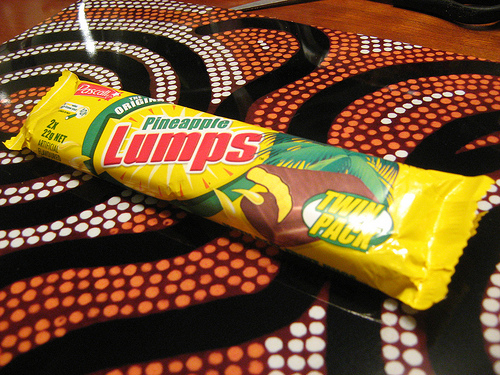Trick-or-Treat! Halloween isn’t just a holiday that allows both adults and children to play dress up, but an excuse for us to eat unhealthy amounts of candy and sweet treats. While Halloween is not a holiday celebrated all around world, candy and other desserts are something we can find just about everywhere.
Samoa
A lot of Samoan meal recipes call for coconut, and the same goes for their desserts. We see coconut in desserts like shortbread cookies, pudding, and cakes. We were able to try some of these recipes at our Samoan Luau this summer and they were such great treats! You can find the recipes for these here.
 Another sweet treat popular in the South Pacific is a candy by the name of “pineapple lumps.” A soft, chewy pineapple-flavored middle is surrounded by chocolate covering.
Another sweet treat popular in the South Pacific is a candy by the name of “pineapple lumps.” A soft, chewy pineapple-flavored middle is surrounded by chocolate covering.
Candy leis are a unique Samoan tradition as well. A variety of different candies are wrapped around a necklace and made into a wearable lei. The leis often incorporate money by folding them into intracate designs. These leis are often given to loved ones during special events such as a graduation, as a sign of love and respect. When the event is over, people celebrate by eating the candy or chocolates.
Mexico
Lucas Salts are a very popular candy in Mexico. Adults may recognize these sour salts, as they are often used to coat the rims of margaritas and other special beverages. In Mexico, Lucas Salts are eaten by themselves as candy, and often sprinkled on fruits and vegetables.
Caramel treats are popular in Latin and South American countries as well. Dulce de leche is a very popular caramel treat, and translated means “candy of milk”. Various versions of this candy are made by slow heating different types of milk until they are caramelized. In Mexico they use goat’s milk to make their cajeta, or caramel.
Congo
Dessert is not typically part of a meal in Africa. You won’t find many people baking cookies, cakes or pies. Fruit salad and fruits alone are sometimes served after a meal, but are not treated as dessert. One recipe I did find as dessert was for peanut mousse (Mousse à la Cacahuète), a traditional Congolese snack. This treat is made from peanut butter, egg whites and cream mousse. Once whipped together, it’s served chilled.
Bulgaria
 Europe is home to many famous chocolatiers, such as Godiva, Cadbury, Nestlé, and Lindt. England’s Rowntree popularized the aeration of chocolate in 1935. The aerated chocolate has little bubbles inside creating an airy texture and it melts very fast in your mouth, and is a popular chocolate choice in Bulgaria. The United States recently followed suit on this trend when Hershey’s brought Air Delights to the market.
Europe is home to many famous chocolatiers, such as Godiva, Cadbury, Nestlé, and Lindt. England’s Rowntree popularized the aeration of chocolate in 1935. The aerated chocolate has little bubbles inside creating an airy texture and it melts very fast in your mouth, and is a popular chocolate choice in Bulgaria. The United States recently followed suit on this trend when Hershey’s brought Air Delights to the market.
Photo Credits: ribarnica, theimpulsviebuy
